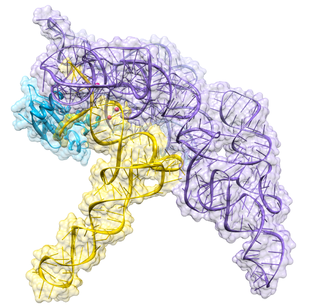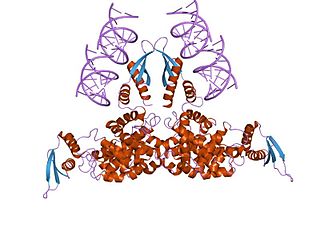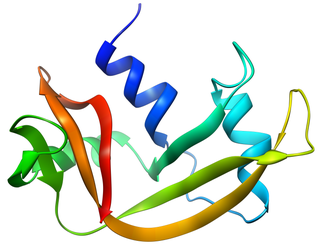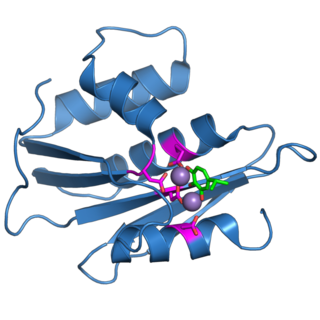Related Research Articles

In genetics, complementary DNA (cDNA) is DNA synthesized from a single-stranded RNA template in a reaction catalyzed by the enzyme reverse transcriptase. cDNA is often used to clone eukaryotic genes in prokaryotes. When scientists want to express a specific protein in a cell that does not normally express that protein, they will transfer the cDNA that codes for the protein to the recipient cell. In molecular biology, cDNA is also generated to analyze transcriptomic profiles in bulk tissue, single cells, or single nuclei in assays such as microarrays and RNA-seq.

Ribonuclease is a type of nuclease that catalyzes the degradation of RNA into smaller components. Ribonucleases can be divided into endoribonucleases and exoribonucleases, and comprise several sub-classes within the EC 2.7 and 3.1 classes of enzymes.

Ribonuclease H is a family of non-sequence-specific endonuclease enzymes that catalyze the cleavage of RNA in an RNA/DNA substrate via a hydrolytic mechanism. Members of the RNase H family can be found in nearly all organisms, from bacteria to archaea to eukaryotes.
The year 1987 in science and technology involved many significant events, some listed below.
The first isolation of deoxyribonucleic acid (DNA) was done in 1869 by Friedrich Miescher. Currently it is a routine procedure in molecular biology or forensic analyses. For the chemical method, there are many different kits used for extraction, and selecting the correct one will save time on kit optimization and extraction procedures. PCR sensitivity detection is considered to show the variation between the commercial kits.

Guanidinium thiocyanate(GTC) or guanidinium isothiocyanate (GITC) is a chemical compound used as a general protein denaturant, being a chaotropic agent, although it is most commonly used as a nucleic acid protector in the extraction of DNA and RNA from cells.

Ribonuclease L or RNase L, known sometimes as ribonuclease 4 or 2'-5' oligoadenylate synthetase-dependent ribonuclease — is an interferon (IFN)-induced ribonuclease which, upon activation, destroys all RNA within the cell. RNase L is an enzyme that in humans is encoded by the RNASEL gene.

Ribonuclease P is a type of ribonuclease which cleaves RNA. RNase P is unique from other RNases in that it is a ribozyme – a ribonucleic acid that acts as a catalyst in the same way that a protein-based enzyme would. Its function is to cleave off an extra, or precursor, sequence of RNA on tRNA molecules. Further, RNase P is one of two known multiple turnover ribozymes in nature, the discovery of which earned Sidney Altman and Thomas Cech the Nobel Prize in Chemistry in 1989: in the 1970s, Altman discovered the existence of precursor tRNA with flanking sequences and was the first to characterize RNase P and its activity in processing of the 5' leader sequence of precursor tRNA. Recent findings also reveal that RNase P has a new function. It has been shown that human nuclear RNase P is required for the normal and efficient transcription of various small noncoding RNAs, such as tRNA, 5S rRNA, SRP RNA and U6 snRNA genes, which are transcribed by RNA polymerase III, one of three major nuclear RNA polymerases in human cells.

Ribonuclease inhibitor (RI) is a large, acidic, leucine-rich repeat protein that forms extremely tight complexes with certain ribonucleases. It is a major cellular protein, comprising ~0.1% of all cellular protein by weight, and appears to play an important role in regulating the lifetime of RNA.

Ribonuclease III (BRENDA 3.1.26.3) is a type of ribonuclease that recognizes dsRNA and cleaves it at specific targeted locations to transform them into mature RNAs. These enzymes are a group of endoribonucleases that are characterized by their ribonuclease domain, which is labelled the RNase III domain. They are ubiquitous compounds in the cell and play a major role in pathways such as RNA precursor synthesis, RNA Silencing, and the pnp autoregulatory mechanism.

Acid guanidinium thiocyanate-phenol-chloroform extraction is a liquid–liquid extraction technique in biochemistry. It is widely used in molecular biology for isolating RNA. This method may take longer than a column-based system such as the silica-based purification, but has higher purity and the advantage of high recovery of RNA: an RNA column is typically unsuitable for purification of short RNA species, such as siRNA, miRNA, gRNA and tRNA.

TRIzol is a widely used chemical solution used in the extraction of DNA, RNA, and proteins from cells. The solution was initially used and published by Piotr Chomczyński and Nicoletta Sacchi in 1987.

In molecular biology, nuclear ribonuclease P is a ubiquitous endoribonuclease, found in archaea, bacteria and eukarya as well as chloroplasts and mitochondria. Its best characterised enzyme activity is the generation of mature 5′-ends of tRNAs by cleaving the 5′-leader elements of precursor-tRNAs. Cellular RNase Ps are ribonucleoproteins. The RNA from bacterial RNase P retains its catalytic activity in the absence of the protein subunit, i.e. it is a ribozyme. Similarly, archaeal RNase P RNA has been shown to be weakly catalytically active in the absence of its respective protein cofactors. Isolated eukaryotic RNase P RNA has not been shown to retain its catalytic function, but is still essential for the catalytic activity of the holoenzyme. Although the archaeal and eukaryotic holoenzymes have a much greater protein content than the bacterial ones, the RNA cores from all three lineages are homologous—the helices corresponding to P1, P2, P3, P4, and P10/11 are common to all cellular RNase P RNAs. Yet there is considerable sequence variation, particularly among the eukaryotic RNAs.

Pancreatic ribonuclease family is a superfamily of pyrimidine-specific endonucleases found in high quantity in the pancreas of certain mammals and of some reptiles.

Ribonuclease 4 is an enzyme that in humans is encoded by the RNASE4 gene.
Nucleic acid methods are the techniques used to study nucleic acids: DNA and RNA.

The retroviral ribonuclease H is a catalytic domain of the retroviral reverse transcriptase (RT) enzyme. The RT enzyme is used to generate complementary DNA (cDNA) from the retroviral RNA genome. This process is called reverse transcription. To complete this complex process, the retroviral RT enzymes need to adopt a multifunctional nature. They therefore possess 3 of the following biochemical activities: RNA-dependent DNA polymerase, ribonuclease H, and DNA-dependent DNA polymerase activities. Like all RNase H enzymes, the retroviral RNase H domain cleaves DNA/RNA duplexes and will not degrade DNA or unhybridized RNA.
Phenol–chloroform extraction is a liquid-liquid extraction technique in molecular biology used to separate nucleic acids from proteins and lipids.
Small RNA sequencing is a type of RNA sequencing based on the use of NGS technologies that allows to isolate and get information about noncoding RNA molecules in order to evaluate and discover new forms of small RNA and to predict their possible functions. By using this technique, it is possible to discriminate small RNAs from the larger RNA family to better understand their functions in the cell and in gene expression. Small RNA-Seq can analyze thousands of small RNA molecules with a high throughput and specificity. The greatest advantage of using RNA-seq is represented by the possibility of generating libraries of RNA fragments starting from the whole RNA content of a cell.
Nicoletta Sacchi is an Italian professor of oncology at the Roswell Park Comprehensive Cancer Center. She is the co-discoverer of the acid guanidinium thiocyanate-phenol-chloroform extraction method to extract RNA from biological samples with Trizol. As a consequence of this groundbreaking discovery she is now considered the most cited woman scientist in the world.
References
- ↑ Peirson SN, Butler JN (2007). "RNA extraction from mammalian tissues" . Circadian Rhythms. Methods Mol. Biol. Methods in Molecular Biology. Vol. 362. pp. 315–27. doi:10.1007/978-1-59745-257-1_22. ISBN 978-1-58829-417-3. PMID 17417019.
- ↑ Chomczynski P, Sacchi N (2006). "The single-step method of RNA isolation by acid guanidinium thiocyanate-phenol-chloroform extraction: twenty-something years on". Nat Protoc. 1 (2): 581–5. doi:10.1038/nprot.2006.83. PMID 17406285. S2CID 28653075.
- ↑ Bird IM (2005). "Extraction of RNA from cells and tissue". Methods Mol. Med. 108: 139–48. doi:10.1385/1-59259-850-1:139. ISBN 1-59259-850-1. PMID 16028681.
- ↑ FortiusBio High Throughput RNA Extraction Filter Paper Card
- ↑ Rossier, O.; Dao, J.; Cianciotto, N. P. (2009). "A type II secreted RNase of Legionella pneumophila facilitates optimal intracellular infection of Hartmannella vermiformis". Microbiology. 155 (3): 882–890. doi:10.1099/mic.0.023218-0. PMC 2662391 . PMID 19246759.
- ↑ Luhtala, N.; Parker, R. (2010). "T2 Family ribonucleases: Ancient enzymes with diverse roles". Trends in Biochemical Sciences. 35 (5): 253–259. doi:10.1016/j.tibs.2010.02.002. PMC 2888479 . PMID 20189811.
- ↑ Dyer, K. D.; Rosenberg, H. F. (2006). "The RNase a superfamily: Generation of diversity and innate host defense". Molecular Diversity. 10 (4): 585–597. doi:10.1007/s11030-006-9028-2. PMID 16969722. S2CID 20922592.
- ↑ Harder, J. (2002). "RNase 7, a Novel Innate Immune Defense Antimicrobial Protein of Healthy Human Skin". Journal of Biological Chemistry. 277 (48): 46779–46784. doi: 10.1074/jbc.M207587200 . PMID 12244054.
- ↑ Köten, B.; Simanski, M.; Gläser, R.; Podschun, R.; Schröder, J. M.; Harder, J. R. (2009). "RNase 7 Contributes to the Cutaneous Defense against Enterococcus faecium". PLOS ONE. 4 (7): e6424. Bibcode:2009PLoSO...4.6424K. doi: 10.1371/journal.pone.0006424 . PMC 2712763 . PMID 19641608.
- ↑ Huang, Y. -C.; Lin, Y. -M.; Chang, T. -W.; Wu, S. -J.; Lee, Y. -S.; Chang, M. D. -T.; Chen, C.; Wu, S. -H.; Liao, Y. -D. (2006). "The Flexible and Clustered Lysine Residues of Human Ribonuclease 7 Are Critical for Membrane Permeability and Antimicrobial Activity". Journal of Biological Chemistry. 282 (7): 4626–4633. doi: 10.1074/jbc.M607321200 . PMID 17150966.
- ↑ Rosenberg, H. F. (2008). "RNase a ribonucleases and host defense: An evolving story". Journal of Leukocyte Biology. 83 (5): 1079–87. doi:10.1189/jlb.1107725. PMC 2692241 . PMID 18211964.